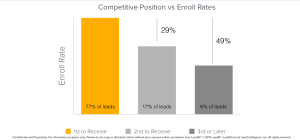
When thinking about marketing attribution and ROI measurement, many marketers tend to get a little anxious. As a marketer, you are spending a tremendous amount of time and budget to drive people to your websites and apps, engage them while they are there, and encourage them to return. Isolating the impact of one single campaign or tactic within all this effort is understandably difficult. Yet without accurate attribution reporting on each of your marketing campaigns, you can’t fully justify your marketing budget. You can’t understand which investments are paying off and which are not worth your time. And you can’t determine the best path toward continued growth.
To help make marketers’ lives easier when it comes to attribution, many optimization tools (such as email platforms, search and recommendations engines, A/B testing tools, etc.) will include some form of attribution measurement. But not all attribution reporting is created equal, as some of these vendors only provide a hazy understanding of the success of your campaigns, potentially leading to missteps in future planning. In this post, I’ll delve into the two biggest mistakes I’ve seen in the world of attribution and outline what good attribution analysis looks like.
Mistake 1: Exaggerating impact
One mistake that many solutions make is to take full credit for any action on your site, as if you or the rest of your marketing efforts had nothing to do with your successes. For example, say a shopper clicked on a recommended product and ultimately purchased something, or ran a search and bought something later, or saw a bounce campaign and didn’t leave the site. In some instances, the vendor you used to create the recommendation, build the search feature, or deliver the bounce campaign will take 100% of the credit for those actions taken.
These types of solutions may even give you a report explaining that they made you millions in incremental revenue, even if your revenue actually decreased. With this approach, they take credit for anything that they touched on your site, making it difficult for you to truly evaluate your marketing efforts and justify your spend.
Mistake 2: Not looking at the full picture
Other solutions only allow you to measure the impact of your campaigns on very narrow KPIs while they ignore broader implications.
For example, if you run an email capture campaign and gather hundreds of extra email addresses, you’ll be pretty pleased with your results. Yet some solutions won’t tell you that the campaign also caused your bounce rate to increase by 3%. Is the campaign still considered successful?
These types of solutions give you some information but don’t allow you to see the rest of the story to judge for yourself.
The correct approach to attribution
When it comes to measuring the benefits of personalization or recommendations, true attribution requires two elements: 1) testing against a control group and 2) measuring the impact of each campaign against all of your key metrics.
Testing with a control group
Advanced statistical analysis that compares every personalization campaign against a control group is absolutely essential to understanding the real impact of a campaign.
Let’s say you implement a new recommendations algorithm on your homepage, and shortly after implementation you see an increase in your conversion rate. If you didn’t measure this campaign against a control, how can you know for sure that this bump is related to the new algorithm? You know better than anyone that there are a host of other factors that can impact your conversion rate at any time.
It’s also possible that the new algorithm negatively impacted your conversion rate — it could have been higher if you left it as is. You need to test this new experience against a control to understand if the results you’re seeing are caused by the new experience, or if they are related to other factors.
Measuring against all key metrics
While the previous example focuses on just one metric, every personalization campaign you run should be measured against all your key goals: revenue, registrations, newsletter signups, visit depth, engagement, etc.
When making any changes or running any campaigns on your website, there are often specific metrics you want to improve. However, no campaign operates in isolation on your site, and it is very common to impact multiple metrics with one campaign. It is possible for a campaign to increase conversions but decrease average order value to the extent that you actually decreased revenues.
To avoid cases like this you need to be made aware when any campaign you run on your site negatively impacts your global goals, even if your narrower goals are met.
Final Thoughts
As a marketer, you need to be able to identify the impact of each of your campaigns in order to justify your efforts, plan your spending, and continue to improve your metrics.
Business & Finance Articles on Business 2 Community
(85)









